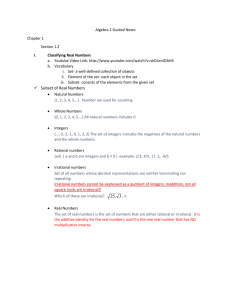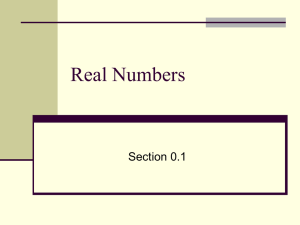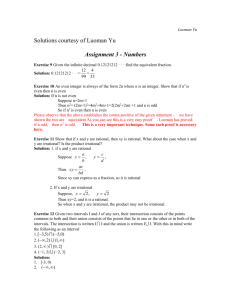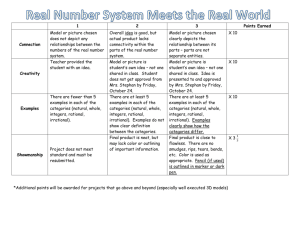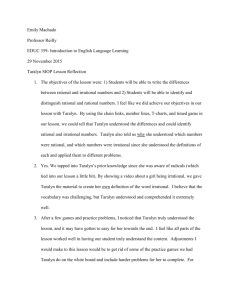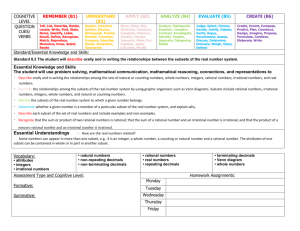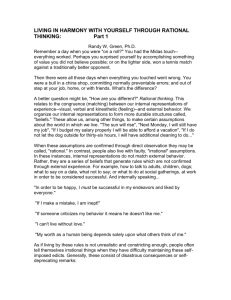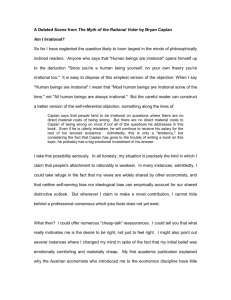Algebra 2 Guided Notes - Mater Academy Lakes High School
advertisement
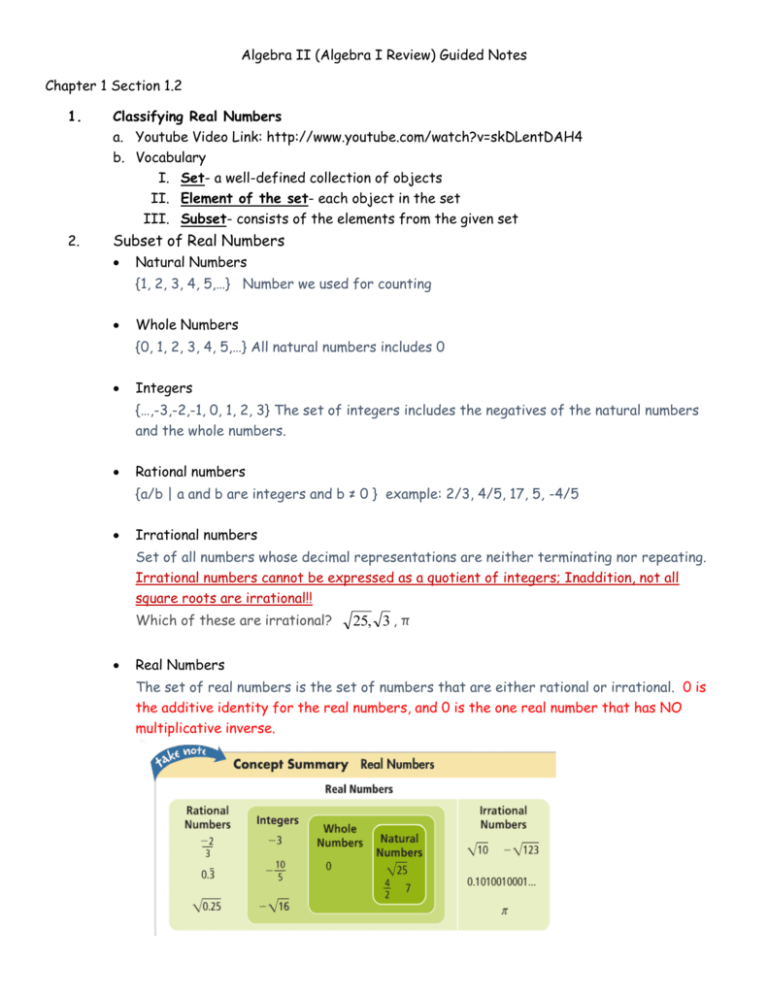
Algebra II (Algebra I Review) Guided Notes
Chapter 1 Section 1.2
1.
Classifying Real Numbers
a. Youtube Video Link: http://www.youtube.com/watch?v=skDLentDAH4
b. Vocabulary
I. Set- a well-defined collection of objects
II. Element of the set- each object in the set
III. Subset- consists of the elements from the given set
2.
Subset of Real Numbers
Natural Numbers
{1, 2, 3, 4, 5,…} Number we used for counting
Whole Numbers
{0, 1, 2, 3, 4, 5,…} All natural numbers includes 0
Integers
{…,-3,-2,-1, 0, 1, 2, 3} The set of integers includes the negatives of the natural numbers
and the whole numbers.
Rational numbers
{a/b | a and b are integers and b ≠ 0 } example: 2/3, 4/5, 17, 5, -4/5
Irrational numbers
Set of all numbers whose decimal representations are neither terminating nor repeating.
Irrational numbers cannot be expressed as a quotient of integers; Inaddition, not all
square roots are irrational!!
Which of these are irrational?
25, 3 , π
Real Numbers
The set of real numbers is the set of numbers that are either rational or irrational. 0 is
the additive identity for the real numbers, and 0 is the one real number that has NO
multiplicative inverse.
Examples:
To which subsets of the real numbers does each number belong?
1.
2.
3.
4.
5.
6.
7.
8.
9.
10.
15
-1.4583
√57
3/10
√64
If you add two rational numbers together, will you sum be rational or irrational?
If you add a rational and irrational number together, will your sum be rational or irrational?
The product of two rational numbers is ___________?
The product of a nonzero rational number and irrational number is _____________?
Your school is sponsoring a charity race. Which set of numbers best describes the number of
people p who participate in the race?
Properties of Real Numbers
Examples: Which property does the equation illustrate?
2
3
1. (− 3) (− 2) = 1
2. (3 ∙ 4) ∙ 5 = (4 ∙ 3) ∙ 5
3. 3(𝑔 + ℎ)2𝑔 = (3𝑔 + 3ℎ) + 2
4. 𝑎 + [3 + (−𝑎)] = 3
5.(2√7)√3 = 2(√7√3)
6. 7 ∙ 7 = 1
1
Algebraic Expressions
To evaluate an algebraic expression, substitute a number for each variable in the expression. Then
simplify using the order of operations. What is the value of the expression
2(𝑥 2 −𝑦 2 )
3
for x = 6, y = -3
Will the value of the expression change if the parentheses are removed? Explain.
In basketball, team can score by making 2-point shots, 3-points shots, and 1-point free throws. What
algebraic expression models the total number of points that a basketball team scores in a game?
An expression that is a number, a variable, or the product of a number and one or more variables is term.
A coefficient is the numerical factor of a term.
A constant term is a term with no variables.
Like terms have the same variables raised to the same powers.
Examples: Combine like terms. What is a simpler form of each expression?
1. −4𝑗 2 − 7𝑘 + 5𝑗 + 𝑗 2
1
2. −𝑎2 + 2𝑏 2 + 4 𝑎2
3.
𝑦2
4
𝑦
+3+
𝑦2
3
𝑦
−5
Solving Equations: An equation is a statement that two expressions are equal.
Solving an equation that contains a variable means finding all values of the variable that make the
equation true.
Inverse operations are operations that “undo” each other.
Example: addition and subtraction, multiplication and division.
One Step Equations
Multi-Step Equations
An equation does not always have one solution!!
An equation has NO solution if no value of the variable makes the equation true.
An equation that is true for every value of the variable is an identity.
An equation is sometimes true if it is true for some, but not all value of the variables.
Example: Equations with No Solution and Identities
A ) 2x + 1 = 2x -1
B) 4 = 4
C) Is the equation always, sometimes, or never true?
1. 7𝑥 + 6 − 4𝑥 = 12 + 3𝑥 − 8
Classwork:
2. 2𝑥 + 3(𝑥 − 4) = 2(2𝑥 − 6) + 𝑥


